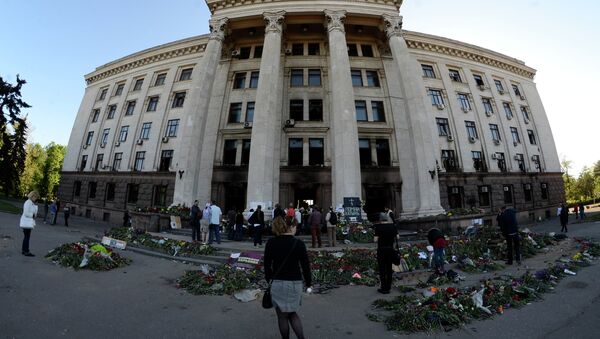MOSCOW, November 2 (RIA Novosti) — The political crisis in Ukraine erupted in November 2013, when the country's Cabinet of Ministers announced a halt to the country's European integration process. The so-called Maidan protests started to be staged in Kiev's central square and soon spread across the country, which resulted in violent armed clashes between the radicals and police and in the follow-up death of around 100 people. Ever since, pro-federalization rallies have been raging in Ukraine's east after the people therein refused to recognize the legitimacy of the country's government put in power following the coup in February.
On May 2, clashes broke out in Odesa between the pro-federalization activists on one side, and the fans of the Odesa and Kharkiv football teams on the other. The latter were later joined by activists Euromaidan. The pro-Kiev radicals, supported by the armed forces of the Right Sector, locked the anti-government protesters inside the city's House of Trade Unions and set fire to the building by hurling Molotov cocktails in it.
Those who were trapped inside had little to no chance of extinguishing the blaze since the fire hoses in the building were out of order. Many of them died when attempting to escape the inferno by jumping out of the windows. Some others were simply shot by the radicals. The tragic incident saw 48 people killed and another 20 injured.
Time-line of the Odesa tragedy and its subsequent investigation.
February 22. Ukraine's parliament, the Verkhovna Rada, voted to oust President Viktor Yanukovych a few hours after he abandoned his Kiev office. The parliament introduced amendments to the constitution to replace the leadership of the parliament and that of the Interior Ministry. An early presidential election was also decided upon, which was to take place on May 25.
February 23. The Verkhovna Rada appointed speaker Olexander Turchynov as interim President.
February 27. An interim government was established in Ukraine, with Arseniy Yatseniuk being appointed as its new prime minister.
Eastern Ukrainian regions announced they did not recognize the legitimacy of the new Kiev leadership and called for federalization of the country.
May 2. Ukraine had seen the bloodiest violence since the February overthrow of President Viktor Yanukovych, with dozens killed in clashes across the country.
The highest casualty toll was reported in the southern Ukrainian city of Odesa, where at least 48 people died and over 200 were injured.
May 3. The Ukrainian Security Service accused former Prime Minister Sergiy Arbuzov and former Deputy Prime Minister Oleksandr Klymenko of fomenting violence in the southern Ukrainian city of Odesa.
Russian Prime Minister Dmitry Medvedev offered condolences to the families of those who died in the city of Odesa.
Russian Foreign Minister Sergei Lavrov urged OSCE to use its potential in a bid to persuade Kiev to cancel the military operation against the people in Ukraine's southeast.
May 4. The coup-appointed Ukrainian Prime Minister Arseniy Yatsenyuk accused the country's Interior Ministry of failing to prevent the Odesa tragedy. He declared that all the senior police officials in Odesa were fired in connection with the Friday tragedy.
Several hundred people took part in the funeral service conducted for the those killed in Odesa's Trade Unions House.
Ukrainian police released 67 anti-government protesters who were detained in the southern city of Odesa after almost a thousand of locals picketed the police department building.
May 5. The acting mayor of Odesa, Oleh Bryndak, signed a decree, declaring May 2 as a day of mourning in memory of those killed in the May 2 tragic events.
May 7. The acting Ukrainian Prosecutor General Oleh Makhnitsky said the May 2 events in Odesa were a well-coordinated and planned action in which representatives of the authorities had participated.
May 13. Ukraine's Deputy Interior Minister Serhiy Chebotar said the investigation of the May 2 riots in Odesa was ongoing.
May 16. Odesa Police Chief Ivan Katerinchuk confirmed that six of the victims of the Odesa May 2 tragedy had died from gunshot wounds, while 32 had choked to death. Another 10 had died when they jumped out of the windows to escape the fire.
May 19. The acting Ukrainian Deputy Interior Minister Vitaliy Sakal said Ukrainian investigators had discovered traces of chloroform in the garbage and that the ashes were removed from the Professional Union Building in Odesa.
The Security Service of Ukraine reported they had detained a group of "terrorists" that had been organizing subversive acts. Four more people were detained in the eastern port city of Odesa. Three of them were employees of a private security company, which were "conducting covert visual surveillance of Kulikovo Field", the place where the tragic events had taken place in Odesa.
May 24. The Deputy Director of the Europe and Central Asia Division at Human Rights Watch Rachel Denber stated that the tragic events in Odesa constituted grave crimes which demanded a serious, impartial and thorough investigation.
June 18. UN observers confirmed the Right Sector members had taken part in the May 2 violence; they were finishing off the wounded.
June 21. The head of an Odesa-based medical-forensic office Grygoriy Kryvda said that at least 20 of the fire victims had been poisoned by an unidentified gas.
August 2. Ukraine's Prosecutor General Vitaly Yarema called for a speed-up in the investigation into the tragic events.
Russia has repeatedly called for an impartial investigation of the Odesa tragedy. However, six months after Odesa massacre, the tragedy remains unanswered.




